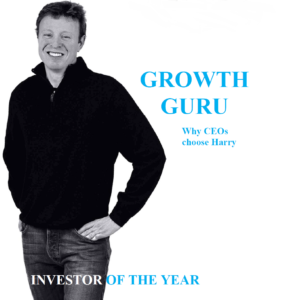
GrowthCap is pleased to announce NEA’s Harry Weller as 2015 Investor of the Year. Having evaluated the universe of partner level professionals at the top performing growth equity firms, Harry’s performance stood out amongst his peers.
“Why did you end up going with Harry when you decided to raise money for Duolingo?” I ask Duolingo CEO Luis Von Ahn. “He wouldn’t stop calling me,” he replied. “I just felt like if he was this intent on investing, he had to really see something in me and my company.” No matter who I talk to about Harry Weller at New Enterprise Associates the story is basically the same. Once he sets his sights on a company, few things will stop him from attaining his goal.

Weller, who originally trained as a pilot in the Navy, brings the kind of unrelenting precision to his investment process you’d expect from someone who can land an airplane on a boat in the middle of the ocean. If you look through his investment portfolio you’ll see several big brand names that he invested in early – like Duolingo, Groupon, MongoDB, and Vonage among others. This track record has won him many accolades including the Forbes “Midas List,” and has made him one of the top VCs in the US.
But it wasn’t always meant to be this way. Weller might still be in the Navy today were it not for the Base Realignment and Closure (BRAC) Commission in the early 1990s. Weller’s squadron was decommissioned early on in the Defense Department’s consolidation process – something he says was one of the luckiest breaks in his life. “When that happened, I was looking around going ‘ok now what?’” he explains. “So I used my software background to get into technology consulting with Aurthur Andersen. I was put on a project with Oracle, during the early days because Larry Ellison had sold a version of Oracle he hadn’t actually made yet. So I was running that project and when it was done Larry told me I should go to business school and get into the business side instead of just doing deployments.”
After that, Weller did go to business school at Harvard, where he took Professor Josh Lerner’s course on venture capital, which he credits with sparking his interest in the field. “I didn’t choose to go into venture capital, it was a very nose to the ground process about what I like to do. I felt like this industry had the right mix of high tolerance for risk, and a requirement to keep up with what’s new.”
Out of school, he returned to the Southeast – he’s originally from Atlanta – and started looking for a VC firm to join. “Looking back, I don’t know why I started there. Venture was not really happening in Atlanta in the 1990s,” he quips. “But around that time, a friend of mine called and suggested Washington D.C. He was starting his own firm – FBR Technology Venture Partners.” While at FBR, he quickly built up a successful track record, prompting Peter Barris to call and ask him to consider joining NEA.
Method investing
Weller comes to the investment process with a deeply technical background – his undergraduate education focused on computational physics, and his work in the Navy further developed his understanding of software engineering and deployment. He’s currently working on a PhD in physics at the University of Maryland. His colleague Scott Sandell, Managing General Partner in the Menlo Park office of NEA explains Weller’s process this way – “Harry is a visionary investor. You’ve heard of method actors, he is a method investor. He’s able to see where the technology is going and identify who the leaders are.”
That method involves a rigorous combination of reading about, gaming, and trying out new technologies. Rather than getting caught up in themes or fads, Weller seems to be more focused on finding companies that are breaking new ground in whatever industry they are in. “I’m as much an early as late stage investor,” he says. “Sometimes it’s not always clear who is viable until later on.”
In the people business
Weller also has a reputation for being one of the nicest people in venture – and that may be his biggest advantage. “If I’m not blown away by a person I can’t invest,” he says. “I’m at a stage in my life where life is too short for bad relationships. I have to have a passion for the idea and a passion for the CEO, or else I can’t make the effort involved in building a company.”
Having a VC say that relationships are important is nothing new and often those “relationships” tend to exist purely at board meetings. But with Weller, it actually seems to be true. The people he works with tend to hang around and come up again throughout different investments. I asked each person that I interviewed for this piece how they would introduce Weller at a party, and apart from some small variations in the opening line they all said, “Harry will become your new best friend.”
Indeed, after spending time with Weller for this piece, it’s hard to imagine him being unable to forge lasting friendships with just about anyone. He disarms quickly, answering questions casually, as though he’s known me for much longer than one day. “He’s not out there networking in the conventional way,” says Scott Frederick, Development Partner and Head of Federal in the Washington D.C. office of NEA. He’s known Harry for decades – including at FBR Technology Venture Partners, where he also worked. “He’s able to tap into technologies on a deep level and build relationships with experts in the field – I think because he can speak to them on their level. People want to work with him after that.”
It’s this quality that keeps CEOs like Wayne Jackson coming back. Jackson first started working with Weller in 1998, when he invested in Jackson’s first company Riverbed Technologies. Riverbed Technologies, was a mobile computing company based in Vienna, Virginia that was acquired by Aether Systems in 2000 for more than $1 billion.

“Harry is just a really nice, normal person,” Jackson says. “He doesn’t have to be smarter than you, and he’s a straight shooter. If there’s an agenda he will tell you right away. He has qualities that we like in humans that aren’t always so common in VCs.”
After the Riverbed sale, Jackson built another company that Weller invested in – Sourcefire. Sourcefire is a Columbia, Maryland-based open source network security firm, known for its FirePOWER network security appliances, which are based on Snort, an open source intrusion detection system. Open source products can be built by a single company like SourceFire, but are broadly supported by a community of developers, individuals, and technologists who often find new ways to extend the usability of a piece of software.
The cybersecurity products SourceFire created with Snort were pioneering in their use of a layered approach to network security. Layering essentially walls off sensitive information from would-be attackers behind a series of increasingly difficult security checks.
SourceFire’s approach caught the attention of many players in the industry, not just Weller. Core Capital Partners, Cross Creek Capital, Inflection Point Ventures, and Sequoia Capital were all involved in the four early stage rounds that established the company. SourceFire would then fend off a handful of takeover attempts before being acquired by Cisco for $2.7 billion in 2013.
Now, Jackson and Weller have teamed up again on a third company, Fulton, Maryland-based Sonatype. NEA led a $25 million financing round, alongside existing investors. Sonatype provides a supply chain service to technology developers that ensures the safety and usability of third party services that make it into a proprietary development process. In December of last year, the company released the first firewall made specifically for software development environments. Other early investors include Accel Partners, Bay Partners, Hummer Winblad Venture Partners and Morgenthaler Ventures.
“Let me introduce you…”
Sonatype wasn’t the only deal to come out of SourceFire. Late last year, Weller joined the board of Sterling, Virginia-based ThreatQuotient after leading a $10.2 million Series A round for the company. ThreatQuotient is a 25-person cybersecurity startup that makes what it calls “Threat Intelligence Platforms.” The company was co-founded by Wayne Chiang and Ryan Trost. Early on, Chiang and Trost were introduced to John Czupak when a seed investor brought him on as a consultant. Czupak, a longtime cybersecurity executive, got his start at SourceFire and is now CEO of ThreatQuotient.
Weller seems to like this kind of repeat relationship. Whether it’s teaming up on new companies or simply introducing people, he is a natural connector and that works to the benefit of the companies he invests in. “Harry is really hands on,” says Duolingo’s Von Ahn. “He asks a lot of questions about what we are doing, but he also comes into each board meeting with a fair amount of intel about what we’ve been up to. Then, sometimes he’ll just call you and say I want you to meet someone and it’s always because they have an expertise that we need.”
Weller invested in Pittsburgh-based Duolingo in the company’s $15 million series B round in 2012. The company has a smartphone app that allows users to learn a new language for free. Von Ahn is an associate professor of computer science at Carnegie Mellon University, and has led two other companies -reCAPTCHA and ESP Game, which were both purchased by Google. Early investors in Duolingo include Union Square Ventures, Ashton Kutcher’s A-Grade and angel investor Tim Ferriss.
Minimally awesome product
Weller’s investment in quality relationships first, and quality companies second, has created a small ecosystem of entrepreneurs, investors, and vendors that seem to orbit around his ideas. While that’s an obvious boon for NEA and Weller himself, it seems to come with an upside for end users of these technologies as well.
Take for example, Cambridge, Massachusetts-based OnShape, a company that has reimagined the world of computer-aided design (CAD). Basically every product in use today is first drawn using CAD. CAD creates the blueprints for manufacturing so that products can be developed and then created through an automated process and come out the same every time. Decades ago, OnShape CEO Jon Hirschtick created the first major CAD software – Solidworks. Now, he is building on that expertise with OnShape to make CAD more collaborative and responsive to new technologies.

“One of the things that we got from Harry early on was a piece of advice that caused us to shift our thinking about this company,” Hirschtick explains. “Often in an early stage technology company you’re trying to get to what is known as a minimally viable product – a version that is basically good enough for users to try out. Harry said to us, ‘instead of a minimally viable product what if we made a minimally awesome product?’ That question shifted our thinking and even though it took longer than it would have to go to market, we ended up with a better product.”
That product has changed the way product designers use CAD. Now they can design products across computers and across devices from a browser and in real-time. It’s like a supped up Google Docs but for stuff. And, it’s poised to fundamentally change and modernize how we make things.
What’s next?
2015 was a busy year for Weller on the new investment side with companies like OnShape, and Code42. Code42, the Minneapolis-based developers of the Crashplan enterprise backup tool closed an $85 million series B round this October led by NEA alongside Accel Partners, JMI Equity, and Split Rock Partners.
“Code42 customers’ backup archive is a unique asset nobody else in security has: all the data,” Weller explains. “As a result, the company has an opportunity to build a leadership position in unlocking the forensic and analytical value of that data.”
In addition to investing in new companies, Weller bookended 2015 with a pair of significant exits. Just as 2015 started, he sold his interest in Pentaho, a California-based business intelligence company to Hitachi Data Systems for nearly a half billion dollars.
Weller also exited SolidFire, a California-based flash storage company in an $870 million sale to NetApp. NEA first invested in Solidfire in 2011, leading its $11 million Series A round. SolidFire was founded in 2010 and is now the market leader in all-flash storage systems. NetApp said it made the acquisition in order to be able to offer the full array of flash storage options and build out its “data fabric” business line. SolidFire CEO, Dave Wright, will lead the SolidFire product line within NetApp’s product operations.
Those exits will give Weller a little more space to find the next new thing in tech. “We’re at a time when the pace of innovation is happening faster than any other time in history,” he says. “A lot of people ask whether that excitement is warranted. But the physics behind that excitement is sound. We aren’t just making new tech – we’re changing business models; we’re changing funding structures; we’re taking the friction of the economy, and that means we’ll have to reimagine that too.”
I ask what new opportunities he’s looking into and he shows me a video game on his computer that provides an immersive virtual reality experience. In the example, players pilot an airplane. “The key here is that the view extends when the pilot moves his head around, that’s just how it looks in real life.” He would know. Then he mentions quantum computing – a field so new it barely exists outside of research labs and likely won’t be investment ready for a few years, “that’s really exciting,” he says. “But who knows what’s next, it probably hasn’t been invented yet. That’s half the fun, right?”
Discover unique insights from growth investors and leading executives.
Sign up for our weekly newsletter.